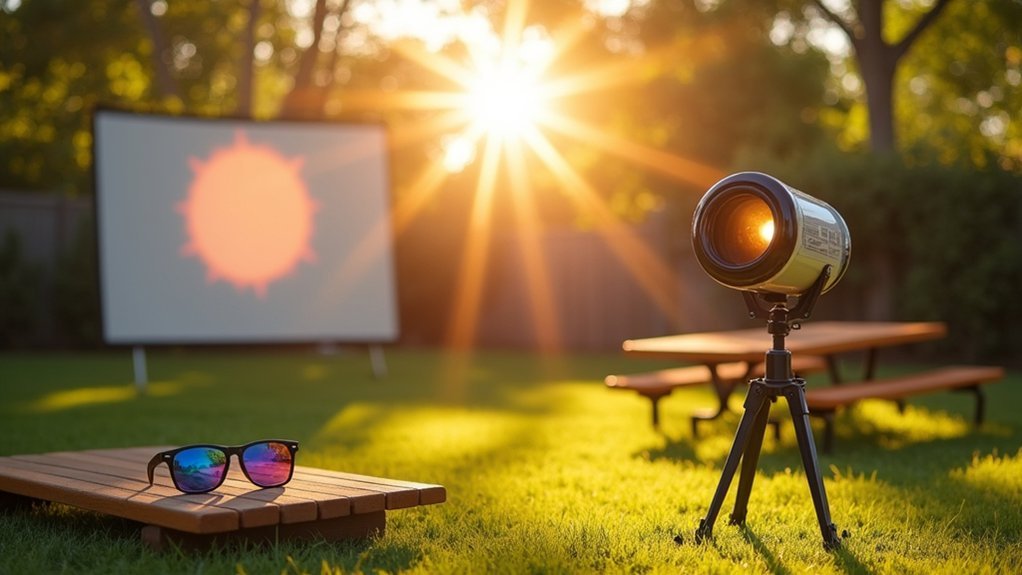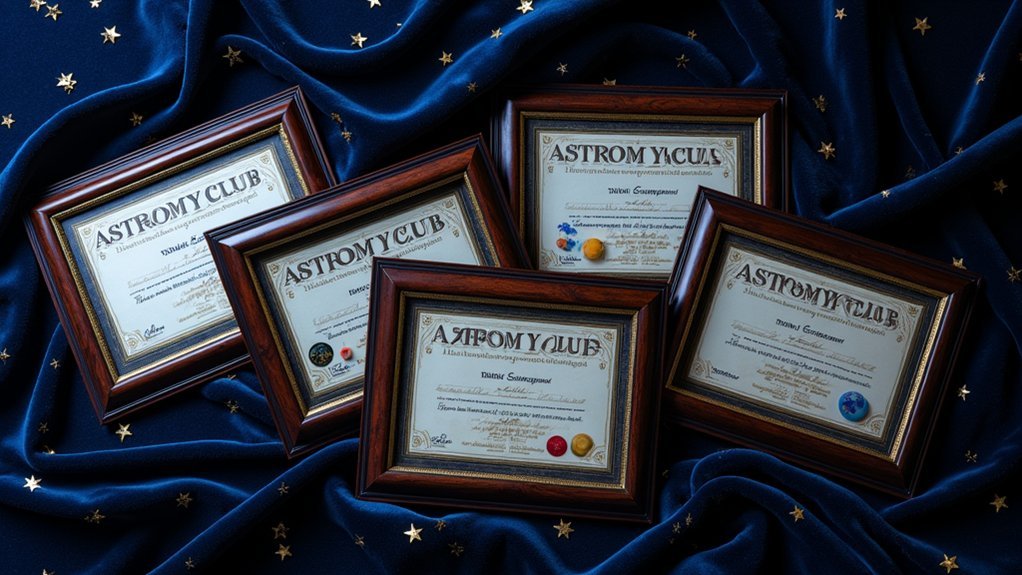Never look directly at the sun without proper protection. Always use ISO-certified eclipse glasses that block 99.99% of harmful rays. Create pinhole projectors with cardboard boxes or use kitchen colanders to safely project sun images. Watch NASA’s live stream for risk-free viewing. Craft decorated paper plate holders for eclipse glasses to make the experience fun. Inspect all viewing devices for damage before use. The safety of your child’s eyes depends on following these essential precautions.
10 Best Kid-Safe Ways to Watch the Sun

When the sun puts on a spectacular show during an eclipse, you’ll want your kids to experience this rare astronomical event safely. Protection is essential as direct sunlight can damage kids’ eyes permanently.
Always use ISO-certified eclipse glasses (ISO 12312-2) with safe solar filters when viewing a solar eclipse. Make the experience fun by crafting decorated paper plate holders for the glasses.
Never compromise on eye safety — only ISO 12312-2 certified glasses provide proper protection during this magical celestial moment.
Don’t have specialized equipment? Create a DIY pinhole projector using a cardboard box and aluminum foil. This allows your children to safely watch a solar event by seeing the projected image rather than looking directly at the sun.
For creative alternatives, hold a kitchen strainer over white paper to see crescent patterns, or watch NASA’s live stream for a risk-free viewing experience.
Certified Eclipse Glasses: What to Look For
When selecting eclipse glasses for your children, always verify they meet the ISO 12312-2 standard, which should be clearly printed along with the manufacturer’s name on authentic products.
You’ll need to carefully examine the lenses for any scratches, tears, or punctures that could compromise their protective capabilities.
Properly certified glasses will block harmful solar radiation, allowing only 0.00032% of sunlight through to protect your child’s delicate eyes during this spectacular celestial event.
ISO 12312-2 Certification Essential
Protecting your eyes during solar viewing requires proper equipment that meets stringent safety standards.
When selecting eclipse glasses, the ISO 12312-2 certification isn’t just a recommendation—it’s absolutely essential to protect your eyes while viewing the solar eclipse.
Verify your eclipse glasses meet safety requirements by checking:
- The ISO 12312-2 certification number clearly printed on the glasses
- Manufacturer’s name and logo to confirm authenticity
- Filtering capability (should block 99.99968% of sunlight)
- Physical condition—reject any with scratches, punctures, or damage
Inspecting For Damage
Even with ISO 12312-2 certification, your eclipse glasses need thorough inspection before each use.
Carefully check for scratches, tears, or dents that may compromise their ability to block dangerous UV rays. Damaged glasses won’t provide adequate protection and could lead to serious eye injury.
Ensure your certified eclipse glasses fit snugly against your face, completely covering your eyes without gaps where sunlight could enter.
When you put them on and look at a bright light source, everything should appear dimly lit without any glow or distortion.
Always discard eclipse glasses showing any signs of damage—safety standards require perfect condition for effective protection.
Creating a Simple Pinhole Projector

You’ll need just a cardboard box, aluminum foil, and white paper to create your own eclipse viewing tool at home.
To make your pinhole projector, punch a hole in one end of the box, cover it with foil featuring a tiny pinhole, and place white paper at the opposite end to catch the sun’s image.
Before the eclipse arrives, test your projector outdoors to guarantee you’re seeing a clear projection of the sun on your paper screen.
Materials You’ll Need
Just five common household items are required to build your simple pinhole projector.
You’ll need a cardboard box to serve as the main structure, aluminum foil to create the projection surface, white paper for the screen, plus scissors and tape for assembly. This combination creates a safe way to view the sun without risking eye damage.
These materials work together to:
- Create a controlled environment – The cardboard box blocks ambient light, making the projected image clearer.
- Filter sunlight properly – The tiny pinhole in aluminum foil projects the sun’s image safely.
- Provide a viewing surface – White paper shows the projection clearly.
- Ensure durability – Tape secures everything in place for multiple uses.
With these simple materials, you’re ready to safely observe the sun!
Making Your Projector
Four simple steps transform your household items into a safe solar viewing device. First, cut a small hole in one end of your cardboard box. Cover this opening with aluminum foil and secure it with tape.
Next, create a tiny pinhole in the center of the foil using a pin or sharp object—this allows sunlight to enter.
On the opposite end of the box, attach white paper to serve as your viewing screen. Position yourself with your back to the sun during the eclipse, pointing the pinhole toward the sunlight. The projected image will appear on the white paper inside.
For better visibility, slightly angle the white paper to catch more light. This simple pinhole projector demonstrates safe viewing practices while engaging children in an educational DIY science project.
Testing Before Eclipse
Once your projector is assembled, testing it before the actual eclipse guarantees you’ll be ready for the big event.
Find a sunny day to verify your pinhole projector works properly. The small hole in the aluminum foil should create a clear image on the white piece of paper inside your box.
During your test run:
- Check if the sun’s shape appears clearly on the paper screen
- Adjust the pinhole size if needed – 1-2 mm usually works best
- Confirm the box is stable and won’t tip over during viewing
- Measure how far the paper screen should be from the pinhole for best clarity
This testing process is educational and gives you time to engage kids in understanding the science before the excitement of eclipse day.
Colander and Strainer Shadow Techniques

While solar glasses remain popular for eclipse viewing, a simple kitchen colander or strainer offers a fascinating alternative that keeps children safely engaged.
Hold the colander above a piece of white paper during the solar eclipse, and you’ll create multiple tiny sun projections simultaneously. The holes in your colander function as a pinhole projector, displaying crescent-shaped images as the moon crosses the sun’s path.
Kids can safely observe these changing patterns without risking eye damage from direct sunlight. Make this a teachable moment by discussing how the crescents shift as the eclipse progresses.
Remember to emphasize eye safety throughout the activity – children should only watch the projections on the paper, never looking directly at the sun itself.
NASA Live Stream: Virtual Viewing Options
For families seeking the safest eclipse viewing experience, NASA’s official live stream provides an exceptional alternative to outdoor observations.
You’ll find this virtual viewing option particularly valuable if you’re not in the path of totality or prefer to avoid potential eye hazards altogether.
When preparing to experience the event through NASA’s digital platform, consider these advantages:
- Complete safety – View the eclipse without specialized glasses or equipment
- Expert commentary – Gain educational insights from NASA scientists in real-time
- Multiple access points – Connect through NASA’s website or various media platforms
- Family-friendly content – Engage children and families with age-appropriate explanations
The NASA live stream combines convenience with thorough coverage, making it an ideal option for classrooms, family gatherings, or individual viewing of this spectacular celestial event.
Smartphone Photography With Solar Filters

Protecting your child’s smartphone camera requires an ISO-certified solar filter specifically sized for the lens, without which permanent sensor damage can occur.
You’ll want to adjust your phone’s settings by turning off auto-exposure, switching to manual focus, and disabling flash to capture the clearest eclipse images.
When setting up with kids, secure the filter with tape, teach them to never remove it during observation, and consider using a tripod at their height to prevent wobbly shots and maintain safe viewing angles.
Filter Selection Fundamentals
When capturing the sun with your smartphone, choosing the right solar filter is absolutely crucial for safety.
You’ll need ISO-certified filters that completely cover your phone’s camera lens to protect both your eyes and the device’s sensor from harmful solar rays.
Always supervise children during solar photography and make certain they understand proper eclipse glasses and handheld solar viewers are mandatory, not optional.
Here’s what to look for when selecting filters:
- ISO certification – confirms the filter meets international safety standards
- Smartphone-specific design – guarantees proper fit over your device’s lens
- No scratches or damage – inspect filters carefully before each use
- Complete coverage – filter must block 100% of harmful rays for safe viewing
Never attempt smartphone solar photography without proper protection, regardless of how brief the exposure.
Phone Settings Optimization
Once you’ve secured a proper solar filter for your smartphone, how can you maximize image quality during the eclipse?
Switch your camera to manual mode to control exposure settings directly. This prevents the bright sun from causing overexposure in your solar photography.
Mount your smartphone on a tripod for stability—shaky hands lead to blurry eclipse images.
Before the big day, test your setup in bright conditions to guarantee peak performance when it matters most.
Several specialized apps can enhance your eclipse photography experience by providing custom settings for celestial events.
Remember that even with these adjustments, your phone’s camera must always be protected with an ISO-certified solar filter to prevent sensor damage.
These simple enhancements will help you capture this rare astronomical event safely while producing impressive results.
Child-Friendly Setup Tips
Kids’ enthusiasm for astronomical events can make eclipse viewing a perfect family activity. When you’re ready to photograph the sun with your smartphone, involve your children in the setup process to teach them about safety during a total eclipse.
Always wear eclipse glasses and guarantee your phone’s camera is protected with an ISO 12312-2 standards filter.
To engage children in safe solar viewing:
- Let them help secure the eclipse glasses over your smartphone lens, explaining how this protects both the phone and your eyes.
- Guide them through testing the filter by checking that it blocks the sun’s brightness.
- Download kid-friendly eclipse photography apps together that emphasize safety.
- Create a checklist where children can mark off safety steps before attempting to photograph the sun.
Crafting a Paper Plate Eclipse Viewer Shield

Creating a paper plate eclipse viewer shield provides a fun, hands-on way for children to safely observe solar eclipses. Take two paper plates and cut a small hole in the center of one while keeping the other intact. Secure them together with tape or glue, ensuring the holes align properly.
Remember that certified eclipse glasses must be worn underneath this viewing shield for proper eye protection—never look directly at the sun without them, even during an eclipse.
| Materials | Steps | Safety Tips |
|---|---|---|
| Paper plates (2) | Cut center hole in one plate | Always wear eclipse glasses |
| Tape/glue | Attach plates together | Look only through the hole |
| Markers/stickers | Align holes properly | Keep glasses on after totality |
| Eclipse glasses | Decorate outer surface | Supervise children |
| Scissors | Test fit before the event | Store shield safely |
Solar Viewing Cards for Children With Special Needs
While paper plate viewers work well for many children, some youngsters with special needs benefit from customized approaches to solar viewing. When preparing solar viewing cards or eclipse glasses for children with special needs, guarantee they meet ISO 12312-2 standards for proper protection.
- Modify standard eclipse glasses by attaching them to paper plates, creating a wider shield that’s easier to secure and more comfortable for children with developmental disabilities.
- Involve your child in decorating their protective eyewear to increase their interest and ownership of safety equipment.
- Use social stories to prepare children with autism for the eclipse experience and explain why wearing special glasses is important.
- Offer DIY pinhole projectors as an alternative for children who may resist wearing eclipse glasses but still want to engage with the solar event.
Telescope and Binocular Safety Adaptations
Although telescopes and binoculars offer exciting ways to observe solar events, they require special safety adaptations when pointed at the sun. When you use these optical instruments, always attach solar filters that meet the ISO 12312-2 international standard to prevent devastating eye damage.
Never improvise with homemade filters or regular sunglasses—these won’t protect your eyes from the sun’s intense rays. Before each use, inspect your solar filters for scratches or damage that could compromise their effectiveness.
Take time to educate children about proper safety measures for solar viewing. Explain why filters are essential and supervise their telescope use during solar observations.
With the right precautions, you’ll create a memorable and safe viewing experience for young astronomers exploring the wonders of our sun.
Eclipse Viewing Parties: Group Safety Strategies
When hosting a solar eclipse viewing party for children, safety must remain your top priority in all planning and activities. Choose open areas where you can effectively supervise children and guarantee they’re properly wearing eclipse glasses throughout the event.
Assign one adult to monitor every few children, making sure everyone understands safety during a total eclipse.
To view a solar eclipse safely while keeping kids engaged:
- Create clear rules: no looking at the sun without proper protection, no running with eclipse glasses on
- Incorporate hands-on activities like making pinhole projectors or decorating glasses
- Establish “viewing zones” where children must stay when looking at the sun
- Keep a first aid kit accessible and guarantee all adults recognize signs of eye damage
These strategies will help keep kids safe while making viewing parties educational and fun.
Frequently Asked Questions
How to Watch the Eclipse Safely for Kids?
Use ISO 12312-2 certified eclipse glasses that fit snugly and supervise kids closely. Alternatively, create a pinhole projector. Remember, regular sunglasses aren’t safe. Never let children look directly at the sun without protection.
What Is the Safest Way to View an Image of the Sun?
The safest way to view the sun’s image is through a pinhole projector. You’ll create a small hole in cardboard that projects the sun onto a surface, allowing you to see it without looking directly at it.
How to See the Eclipse Without Glasses for Kids?
You can help kids see the eclipse safely without glasses by making a pinhole projector with cardboard and foil, using a colander over white paper, or watching NASA’s livestream for an educational experience.
How to Protect Kids’ Eyes From Eclipses?
Always use certified eclipse glasses that fit securely over your child’s eyes. Never let them look directly at the sun unprotected. Supervise constantly, check glasses for damage, and consider safe alternatives like pinhole projectors.
In Summary
Remember, you’ll never want to look directly at the sun without proper protection. By using these kid-safe viewing methods, you’re giving your children a magical astronomical experience while protecting their precious eyesight. Whether you’re crafting a pinhole projector or watching NASA’s livestream, you’re creating memories that spark scientific curiosity. Enjoy the solar spectacle together—safely and memorably!





Leave a Reply